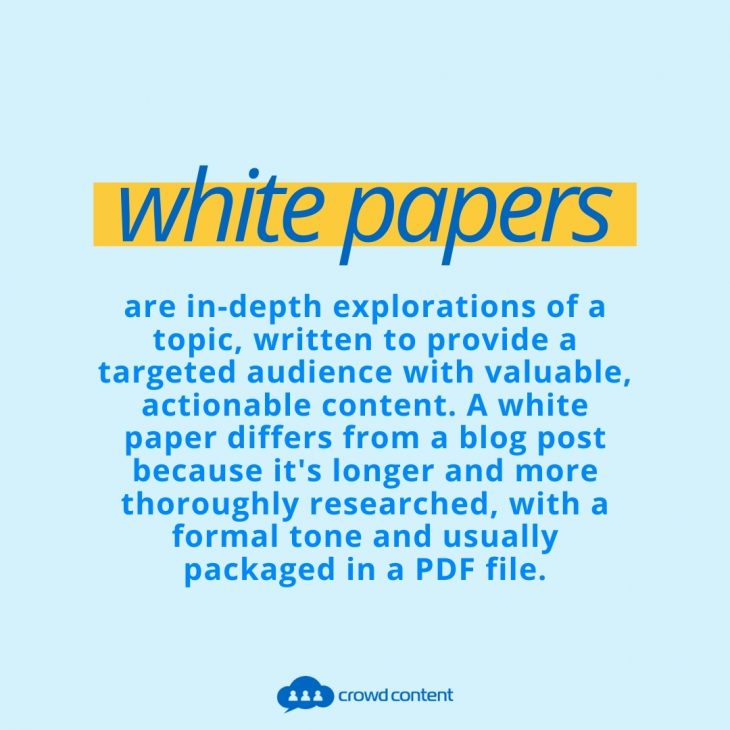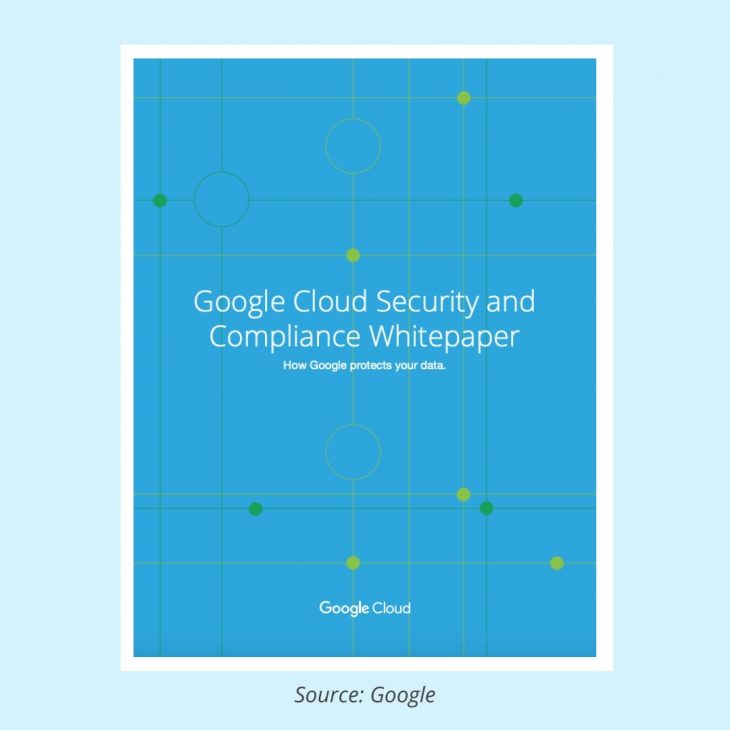We created this post to answer many of the questions our clients had about white paper creation and provide some good white paper examples. Please get in touch if you have any other questions.
Marketers that understand how to create content for every stage of the buyer journey know that leveraging different types of content is critical.
One of the most valuable mid-funnel content types you can leverage is the white paper. These are incredibly valuable resources for buyers who are looking to learn more, evaluate options, and ultimately help nudge them towards the decision stage of their journey.
But, white papers need to be amazing to accomplish this goal in a world where readers expect more and more of the content they consume.
In this post, we’ll go over what makes a good white paper and then highlight some great white paper examples you can emulate.
White Papers at a Glance
White papers are in-depth explorations of a topic, written to provide a targeted audience with valuable, actionable content. A white paper differs from a blog post because it’s longer and more thoroughly researched, with a formal tone and usually packaged in a PDF file.

This doesn’t mean it shouldn’t be engaging — it means the priority is giving readers authoritative information they can use to solve a particular problem.
Initially, a white paper was solely a government technical document that helped to gauge public reactions to legislative changes. Organizations and businesses now use them as part of their content marketing strategies to influence decision-makers.
White papers can help you in the following ways:
- Act as lead magnets that leads download in exchange for their contact information
- Drive SEO results if published and indexed on your site (not in a PDF)
- Establish you as an authority in your space
Why Are White Papers Effective?
A white paper is effective primarily because it communicates your expertise to other businesses and potential buyers and is a valuable asset that these people can use.
Because your audience values them, you can write white papers with the aim of influencing b2b marketers or put them behind a sign up form on a landing page to generate leads or grow your subscriber base.
A good white paper contains unique, valuable information that your target audience of potential contacts would find difficult to find elsewhere. When you understand what your target market is looking for — you can preempt and exceed expectations by producing content the reader needs.
Good white papers address a common problem or challenge your audience is facing and provides a comprehensive solution. Spending time to understand what these challenges are and what questions your audience has is critical.
SIDENOTE – If you choose to publish your white paper, or a portion of it, ungated then your white paper can also help to drive SEO traffic. When you’re researching what topics you should cover, you should also find search terms that your audience uses in Google when trying to address the challenges you’ll cover. Be sure to build that into your content to capture valuable organic traffic.
In the Inc. blog, Victor Ijidola points out two studies that back up how white papers improve marketing success. According to one by Eccolo Media, out of 10 types of content, white papers were ranked as the most helpful form to use in the initial sales phase. Furthermore, a survey by TechTarget reported that 91% of IT buyers consider a white paper to be the second most effective type of content to use in the first stage of buying — with product literature ranked first.

Harness the Broad Reach of Content Marketing
Blogs, case studies, eBooks, e-newsletters and infographics are just a few content types useful in content marketing. The acceleration of digital marketing and the growing influence and reach of technology means having a well-defined content marketing strategy is more crucial than ever. Its effectiveness lies in the indirect approach of becoming more than just a brand to consumers by adding value to their lives through content.
Social media and email marketing are particularly useful due to their prevalence in consumers’ everyday existence. Since it became the standard for people in our society to carry a smartphone, the reach of these channels has increased. These are great channels to distribute and promote your content.
Most people spend a significant portion of their day checking emails and scrolling through their various social media feeds for updates. If you’ve had a blog and noticed how effective it is as a means of engaging potential customers, creating a white paper would likely enhance your content strategy even further.
Ultimately content marketing needs great content to fuel it. You need content to promote and hook visitors in, who you can then nudge down your funnel by progessively showing them content that makes them more interested in your products or services.
When it comes to mid-funnel and bottom of funnel content, white papers are amongst the best tools at your disposal. As you map out your funnel, be sure to identify what white papers you can create at these later stages to convert more of your traffic.
Best Uses for White Papers
The modern buyer is savvy, and they understand that research is critical when they’re choosing which product or service to use. A well-written white paper feeds this thirst for knowledge while subtly positioning your solution as the definitive answer to their need. This is part of the reason why they’re so popular with workers and operators within the tech industry.
Often times these buyers will be researching products or services to solve a problem or challenge they’re facing. White papers that solve these problems are incredibly useful to potential buyers.
White papers are also excellent tools for B2B marketers who are establishing themselves as thought leaders in their niche. You can expand your network and build awareness by inspiring fellow businesses with insightful and authoritative content which can lead to them contacting you when they need help that only you can provide.
Your sales team will thank you if you have great white papers they can leverage. White papers perform a variety of useful functions throughout the sales process:
- White papers establish thought leadership and attract sought-after affiliates and partners.
- They teach potential customers and current clients relevant and valuable information.
- The content in a white paper is educational and not at all sales-focused.
- A business benefits white paper informs the reader about a product without using sales pitches.
- Technology benefits white papers are more technical and detailed about specific features.
- Product comparisons are popular types of white paper that give the audience impartial information to help them make a choice.
- You can generate leads if you put them behind a paywall or contact form — this can be especially effective if you already have a blog or provide content that people read regularly.

Know Your Target Audience
Before you start writing, you must develop a clear understanding of your audience. For example, if your subject matter is aimed at expert engineers, your content should be appropriately technical. On the other hand, if your audience is content writers — they’ll enjoy slightly more elaborate adjectives and fewer statistics. You should also reflect these preferences in the white paper design and layout.
Who Is Your Audience?
Firstly, ask yourself who you want to target. Build a profile of an individual representative (a persona) of your target audience and find out what they need. Search engine data gives business owners a uniquely honest and direct insight into the queries your audience has. You can also interview people in this audience, or ask your sales team what questions they often hear during negotiations.
To write the best white papers, you’ll need to find out the questions your audience needs answering.
How Do Their Needs Align With Your Business Offering?
Now you’ve established the audience’s question; you must find a way of providing them with factual information that compels them to use your product or service to fulfill that need. Remember — it’s not a direct sell. You need to frame the solution as your brand, as opposed to explicitly pointing the reader towards it.
What Are the Main Elements of White Papers?
A captivating and effective white paper relies upon six essential elements:
- Captivating title and headlines: The title is the first opportunity to have to entice readers in. Clear and compelling titles and headlines keep the audience interested and provide markers to help them navigate your content.
- Executive summary: This helps decision-makers whose time is precious to make a quick decision about whether you’re delivering a solution they require. It’s a summary of the key points, with a succinct conclusion that doesn’t leave any questions unanswered.
- A clear introduction or abstract: An introduction should clearly outline your main points and tell the reader what to expect.
- Thoroughly researched and actionable content: This is the main body of your content and the area where the value lies. You must conduct thorough research to provide information that’s easily digestible but goes into enough depth to be a complete resource.
- Snackable layout: Don’t underestimate how crucial layout and design are. Readers quickly lose interest in monotonous content with unbroken blocks of writing. So, make sure you use blocks of color, diagrams, pictures, headings, subheadings and lists to break up the content and keep the audience engaged.
- Implement a clear distribution strategy: Now you’ve written your white paper, you need to release it into the world as part of your content marketing strategy. You’ll need a clear plan in place about whether you release it for free on social media or build a broader strategy around a paywall or sign up form.
How to Promote White Papers
There are myriad ways to ensure maximum exposure for your content, and it’s a time-consuming piece of writing to create — so make sure it gets the reach it deserves. In particular, you’ll need a well-structured promotion plan to make sure your B2B white papers reach a wider audience. Here are several ideas to help you distribute your content :
- Create a landing page on your website with a short opt-in form to download the white paper
- Create a blog post promoting the white paper or post a portion of your white paper and ensure it’s SEO optimized to rank and drive organic traffic
- Promote your white paper by publishing it with hashtags on LinkedIn, Twitter, Facebook, YouTube, Quora, Instagram and Pinterest
- Submit a guest post to an influencer’s blog with a backlink to your landing page for your white paper
- Use email to promote your white paper to your existing mail list, or pay to send a sponsored email to a relevant partner’s list
- Host a conference, podcast or webinar about your white paper and interview industry experts
- Develop relationships with fellow influencers in your vertical and encourage them to share your white paper
- Email the owners of resources lists and ask them to feature your content
- Share your white paper with your partners and affiliates
- Create an infographic based around the info in your white paper
Where Does a White Paper Fit Into the Buyers Journey?
As mentioned earlier, statistics suggest that white papers are most useful at the consideration stage of the customer journey. This is when a consumer is most likely to conduct extensive research regarding their purchase. They understand what their problem is, and they’re looking for a solution. Encouraging downloads and getting contact details at this stage can be the most effective way of finding leads and converting them. The three steps on the sales journey are:
- Awareness stage, where you capture the audience’s interest
- Consideration stage, when they’re gathering information
- Decision stage, when they decide which product of service to use
At the consideration stage, you have the opportunity to give them information about how you intend to solve their problem. Once you’ve obtained their contact details, you can follow up with targeted content to further encourage a conversion.
White Paper Examples and Resources
You can find an array of helpful resources and excellent white paper examples from some of the biggest companies in the world. Here’s a selection of useful tools and resources for white paper writing.
Sample White Paper Templates
The American Marketing Association has a handy white paper template.
B2B
HubSpot produces a slew of great content resources including a range of white papers. Their white paper on How to Use Instagram for Business is a great example of a piece that offers solutions to a common challenge many of its audience face – how are B2B companies supposed to leverage Instagram?

An outstanding example of a B2B white paper is Networking and Your Competitive Edge from Cisco. It uses a futuristic and sleek design to communicate the benefits of its services to decision makers.

LinkedIn is highly adept at using content to build a relationship with its users. The Sophisticated Marketer’s Guide to Content Marketing helps content marketers to succeed with valuable insights from industry leaders.

B2C
While most white papers are aimed at B2B audiences, they’re often just as valuable for B2C audiences.
Google wrote a detailed piece entitled the Google Cloud Security and Compliance Whitepaper, targeted at the public as much as it’s aimed at organizations. It aims to communicate the brand’s dedication to security and privacy, encouraging trust and affirming Google’s commitment to its users online safety.

Increase Conversions at Each Stage of Your Sales Funnel
White papers are useful for many reasons, but their primary advantages are that they establish you as a thought leader in your field while improving your website’s search engine ranking. No matter what your area of expertise is, a well-constructed white paper instills confidence in consumers and partners that you can provide the solution to their problem.
To find out more about content marketing strategies, sign up to Crowd Content’s blog, and get actionable SEO and digital marketing advice delivered straight to your inbox.




